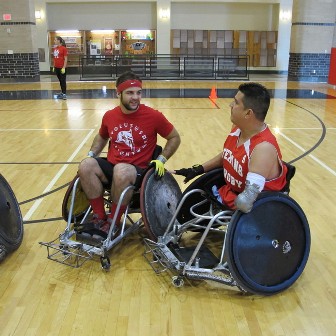Wheelchair rugby and basketball players are aggressive, conditioned and determined,
just like people without disabilities. Unlike them, though, is their likelihood of
employment and economic independence. A new study from the University of Houston Department
of Health and Human Performance (HHP) finds playing an adaptive sport can have dramatic
results on the athlete and the economy. 
“Our analysis shows that playing an additional year of adaptive sport is associated with an approximately 4 percent increase in likelihood of employment every year for 10 years before the benefits flatten out,” said Michael Cottingham, associate professor and the study’s principal investigator. “Resources to support disability sport are lacking, though, in part because of the perceived lack of economic return of investing in these programs.”
The study was published in the international, multidisciplinary journal Disability and Rehabilitation.
The employment rate for individuals with disabilities is about 29 percent compared to a national employment rate of 95.4 percent. If the disability forces the individual into a wheelchair, the percentage drops to 18 percent, according to the U.S. Census Bureau’s Survey of Income and Program Participation.
Cottingham notes previous research has found disability sport provides a strong social
support system, increased self-confidence and peer-education system, which helps athletes
identify resources to gain employment and mentorship. 
“These factors are probably directly and indirectly impacting employment,” he said. “To what extent we don’t yet know, but what seems clear is that disability sport is a catalyst.”
Cottingham and his team surveyed 131 wheelchair rugby and wheelchair basketball athletes about the number of years participating in sports before and after the onset of their disability, employment before and after the onset of their disability, as well as demographic questions.
“The number of years since disability onset was positively associated with employment and the more severe the injury the less likely the individual maintained employment,” Cottingham said. “The data also show this negative relationship between injury severity and employment becomes less significant the longer they played sports. Over time, the fitness and health benefits are probably mitigating the disadvantage of having a more severe impairment.”
Cottingham says results from their study support a stronger commitment and promotion of adaptive sport, which can be expensive as athletes incur the costs of specialized wheelchairs and travel to competitions. He said there is an economic benefit as well.
“If an additional 100,000 individuals, or 2 percent of the working-age wheelchair population in the country, were to play adaptive sports for only one year, our study estimates approximately 4,000 of them would become employed, and this new employment would add approximately $40 million to the economy in the form of household income.”
Cottingham said the study is the first of its kind to examine the effects of participating in adaptive sports on employment, and one of the first studies of employment rates among individuals with physical disabilities not limited to a specific disease.